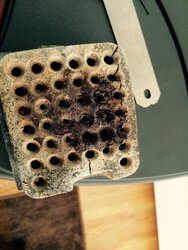This will be an unsatisfying answer but nevertheless, sometimes. The reality is that there are chemical compounds that don't play nicely with different grades of stainless either. Stainless would be less likely to be reactive with various byproducts of burning pellets. Look at it this way, it's unlikely that using stainless will hurt.. much
Also...
I also wanted to add after taking another look at Chken's burn pot; if you are getting clear crystilization like that, you are developing fouling (basically scale but on the fireside). When your pot gets to this point, you should wash it.
Let it get completely cool and simply place it in very clean water. Many of the compounds that will corrode iron are salt based and are very water soluble.
I use de-ionized water at work but evaporation distilled water from any grocery store is great too. You can even use home filtered water if that is all you have. Simply drop the pot in a large enough bucket so that you can keep the part submerged while you work on it and get a wire brush. I have the small wood handled brass ones laying around for my accounts so I use one of those. Let it soak for a few min and gently brush off any remaining deposits. The goal here is to get the corrosive byproducts, not hack away at any stuck carbon/clinkers.
When you have finished brushing, remove the burn pot and give it a quick pat dry with a paper towel or tag. Now, this is important if you don't want a ton of rust on your BP, get a hair dryer, set it as high as it goes, and quickly get the pot bone dry. You should get very little, if any, rust and that can be quickly removed with your (also dried) metal brush.
I don't go nuts with this. Once or twice a season is usually enough. Let your eyes judge. If it looks like Chken's photo I referenced above(not picking on you at all, just a perfect picture of crystal formation), it's time.



 , and it is not flaking at all...
, and it is not flaking at all...
